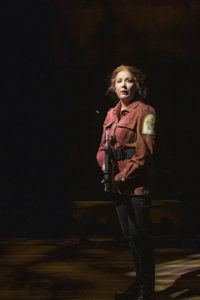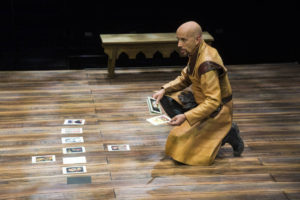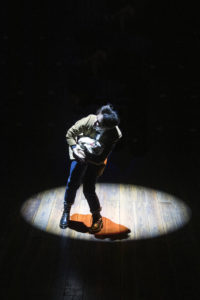
“Henry VI: 2 and 3” at the Utah Shakespeare Festival is long, uneven, and worth it
Don’t let the length and density of “The Conclusion of Henry VI: Parts Two and Three” at the Utah Shakespeare Festival stop you seeing it.
Granted, this production of William Shakespeare’s classic game of thrones is not for the faint of heart. Although both plays are shortened, they are still two hours each — with a half-hour break between — presented as a single-ticket production and featuring the same actors and artistic staff. And while this production is the least impressive part of the festival’s stellar summer season, it’s still worth your time if you are a Shakespeare fan, and especially if you’re trying to “complete the canon.”
Directed by Henry Woronicz, the same creative mind behind Part One in the 2018 season, Parts Two and Three face some of the same issues as the first one. Woronicz makes bold choices to breathe a little more life into these somewhat stuffy plays. While the histories in general have an unwarranted reputation for being boring, the Henry VI plays might be the most difficult to digest as they chronicle the War of the Roses and its accompanying musical crowns.
It’s a repeated pattern of triumph, dialogue, backstabbing, battle, triumph of a new faction, dialogue, backstabbing, battle, etc. And it can become monotonous.
While some of Woronicz’s experiments didn’t work, he should be applauded for having the bravery to try.
Woronicz succeeds in taking a massive and complicated story and making it not only digestible but also entertaining. Yes, the program notes help a great deal, and it’s worth the investment for the full souvenir program with actor bios and photos to help keep everyone straight, especially as actors take on different roles throughout the production.
Longtime patrons of the Utah Shakespeare Festival will be comfortable with actors playing different roles, but typically each character only has one costume. Not so in Parts Two and Three. Once again, Lauren T. Roark has designed some of the best costumes we’ve see on the USF stages, but one of Woronicz’s storytelling devices is to gradually move his characters through time, especially during Part Three. So the same actor might be playing the same character, but he could wear a few different outfits as the centuries fly by.
It’s a fascinating idea — using the visual cues of costumes and props to move the storyline throughout the ages as a commentary about how the political problems of that time are still reflected today — but like some of Woronicz’s creative ideas from Part One, they falter in execution. Until you understand what’s happening, you might find yourself distracted from the play as you wonder why a character is wearing a ballcap. Did he forget to take it off backstage before entering? And, wait, did they really have guns that looked like that in the 15th century?
Stepping away from those thoughts for a moment, there is a glue holding the storytelling together amidst the occasional confusion. That is the acting.

Jim Poulos expertly inhabits the role of timid King Henry VI — a seemingly kindhearted but naive ruler who is obviously in way over his head. Complicated male characters who don’t always exhibit stereotypically “manly” behavior are to be commended and celebrated (we need more of them), but that’s a modern take on Shakespeare’s Elizabethan culture. It’s clear that Shakespeare intended to write Henry as a weak leader who is browbeaten by his wife and whose failures led to a civil war. All of that said, Poulos is absolute perfection in the role Shakespeare wrote.
Contrasting his character is Stephanie Lambourn as the fiery and resolute Queen Margaret, whose character defies stereotypically “womanly” behavior — at least for the time in which the play was written. Again, strong female characters are to be commended and celebrated today (we need more of them), but the Queen’s embrace of stereotypically “manly” behaviors portrays her as stepping outside her role and usurping her husband’s authority. Of course, this is on the Bard and the customs of the time, not on Woronicz or Lambourn, who sizzles in the role. Perhaps, though, her character is more redeemable in Part Three, when Shakespeare’s script allows her to show strength as a woman and not just as a male caricature.

Joining Poulos and Lambourn in a rock-steady performance is Michael Elich as Richard Plantagenet, Duke of York. His character is cunning and conniving and you never doubt it with Elich in control. He continues to own the stage whenever he sets foot upon it — even as he steps away from York to play a commoner with joyful abandon.
Yet with Woronicz’s bold choices — including modern music utilized in both revelatory and distracting ways — his directing is almost a character unto itself.
Modern adaptations of Shakespeare have their place. They can help us better examine enduring themes and eternal truths. The finale of Part Three drives home these ideas in visually exciting and emotionally powerful ways. Woronicz triumphs here, but ultimately, it’s a costly victory because of the confusion sowed by his devices earlier on.
While some of Woronicz’s experiments didn’t work, he should be applauded for having the bravery to try. And, after all, a black box like the Eileen and Allen Anes Studio Theatre is the type of venue that is perfect for experimentation.

One aspect of this production where experimentation absolutely succeeds is the casting of Emelie O’Hara as Richard, Duke of Gloucester and the future King Richard III. That’s right, a short woman — the type of actor typically cast as a boy in Shakespearean production — carries the role that becomes one of the Bard’s greatest villains. And she owns it.
The first moment that O’Hara lopes onto stage, her arched back immediately revealing her identity, might leave some audience members questioning the casting. But any doubts are erased as O’Hara dominates the role. She is downright chilling as Richard (just wait for the scene with the baby), and we can only hope she is again cast for the part in next year’s “Richard III.” She’s wicked good.
Overall, Woronicz faced a gargantuan task of wrangling two epic and easily confusing history plays into one understandable and entertaining production. It has its bumps, but for the most part “The Conclusion of Henry VI: Parts Two and Three” is a success, and a great opportunity for Bard buffs to cross two more off the list.
The Utah Shakespeare Festival’s production of “The Conclusion of Henry VI: Parts Two and Three” continues through August 31 in the Eileen and Allen Anes Studio Theatre at Southern Utah University’s Beverley Center for the Arts in Cedar City. Tickets are $52–$56. Visit bard.org or call (800) 752-9849.
Articles related to “‘Henry VI: 2 and 3’ at the Utah Shakespeare Festival is long, uneven, and worth it”
Visionary direction makes for a macabre “Macbeth” at Utah Shakespeare Festival
Charm, inside jokes minimize the tired tropes in “The Liar” at Utah Shakespeare Festival
Utah Shakespeare Festival’s “An Iliad” is a powerful rumination on the nature of war



